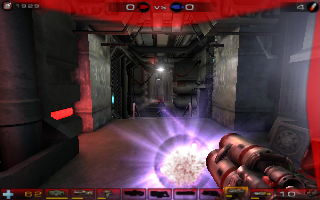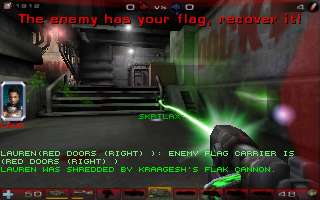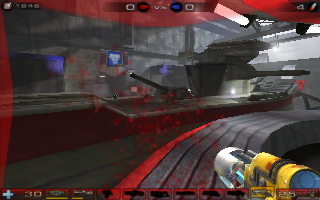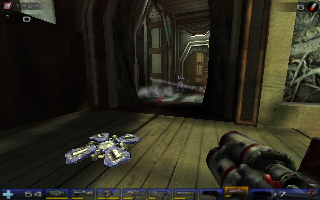First post, by bluejeans
Fired up a geforce 9500gt in xp and found that 640x480 was the minimum resolution in zdoom. I understand intel integrated chipsets can still do it, but amd/ati also suffers from this.
Fired up a geforce 9500gt in xp and found that 640x480 was the minimum resolution in zdoom. I understand intel integrated chipsets can still do it, but amd/ati also suffers from this.
I've GT 620 in xp, and Alley cat still playable on that box.
-fffuuu
It's a driver issue. Support for 320x200 (and most likely any other resolution under 640x480) was removed some time around 2007 or 2008, I think. I remember having to deal with issues where other people couldn't get a tech demo to run in 320x240 around that time. It worked fine on my system, but after updating my video drivers, I had the same issue.
DOS games are not affected, as they don't use the drivers.
Wasn't there a DirectX control panel which allowed for the selection of "ModeX" ?
Edit: Found something. http://www.majorgeeks.com/files/details/micro … trol_panel.html
"Time, it seems, doesn't flow. For some it's fast, for some it's slow.
In what to one race is no time at all, another race can rise and fall..." - The Minstrel
//My video channel//
wrote:Wasn't there a DirectX control panel which allowed for the selection of "ModeX" ?
Mode X is 320x240.
320x200 is VGA mode 13h.
One could say 1987. 320x200 on VGA since was really 640x400 and you've been living a lie for that long 😉
ModeX is not a specific >320x200 mode. ModeX 320x200 exists as well (buffers yay). Furthermore, 320x240 can also be done with VESA2 without ModeX involved (Rendition yay)
But yeah it's a driver mode list thing. FWIW recent Intel HD chips still sport and expose 320x200 and other lo-res modes to this day.
Just to make it perfectly clear: most hardware still supports the resolution; it's just not exposed to Windows. If you manage to boot your machine from a DOS/FreeDOS boot media and run a game that doesn't totally balk at modern CPUs, it should still display just fine on anything recent.
For example, I'm using a CF to IDE adaptor on my retro machine. I shoved the CF card into a card reader and told my BIOS to boot from it. Obviously sound doesn't work, and most memory managers don't understand the concept of gigabytes, but with a barebones config, I could run stuff like Jetpack and Skyroads no problem.
wrote:Just to make it perfectly clear: most hardware still supports the resolution; it's just not exposed to Windows. If you manage to boot your machine from a DOS/FreeDOS boot media and run a game that doesn't totally balk at modern CPUs, it should still display just fine on anything recent.
For example, I'm using a CF to IDE adaptor on my retro machine. I shoved the CF card into a card reader and told my BIOS to boot from it. Obviously sound doesn't work, and most memory managers don't understand the concept of gigabytes, but with a barebones config, I could run stuff like Jetpack and Skyroads no problem.
Any reason why you use CF to IDE and not SD to IDE? I got a SD version but it's picky with some brands of card.
wrote:Just to make it perfectly clear: most hardware still supports the resolution; it's just not exposed to Windows. If you manage to boot your machine from a DOS/FreeDOS boot media and run a game that doesn't totally balk at modern CPUs, it should still display just fine on anything recent.
For example, I'm using a CF to IDE adaptor on my retro machine. I shoved the CF card into a card reader and told my BIOS to boot from it. Obviously sound doesn't work, and most memory managers don't understand the concept of gigabytes, but with a barebones config, I could run stuff like Jetpack and Skyroads no problem.
I remember using some utility that allowed to introduce new video modes in windows, provided that the video card hardware allows the desired resolution / frequency.
I guess that you could re-introduce 320x200 using that utility.
I have traveled across the universe and through the years to find Her.
Sometimes going all the way is just a start...
wrote:Any reason why you use CF to IDE and not SD to IDE?
As far as I know, CF to IDE adaptor is passive (mechanical) while SD to IDE is a converter (SD card reader + fake IDE disk circuit).
wrote:Just to make it perfectly clear: most hardware still supports the resolution; it's just not exposed to Windows. If you manage to boot your machine from a DOS/FreeDOS boot media and run a game that doesn't totally balk at modern CPUs, it should still display just fine on anything recent.
For example, I'm using a CF to IDE adaptor on my retro machine. I shoved the CF card into a card reader and told my BIOS to boot from it. Obviously sound doesn't work, and most memory managers don't understand the concept of gigabytes, but with a barebones config, I could run stuff like Jetpack and Skyroads no problem.
Good point. I've booted an MS-DOS hard drive on various newer machines (usually to run a benchmark or test setmul) and never had issues with VGA games displaying on whatever video chipset was on that machine.
The more I learn, the more I realize how much I don't know.
OPL3 FM vs. Roland MT-32 vs. General MIDI DOS Game Comparison
Let's benchmark our systems with cache disabled
DOS PCI Graphics Card Benchmarks
Azarien hit the nail on the head for my original thought process when I was looking for a drive replacement. The CF adaptors have also been around much longer and are tried and tested. I wasn't sure what to make of the SD adaptors when I saw them. As a side-note, Industrial-rated CF cards (designed for use as IDE disks) often have better small file performance than SD cards (even super-fast U3 cards). At least for those I own and have benchmarked.
As for creating the custom resolution: you can totally still do that:




If using the NVIDIA Control Panel, you'll need to set the timings to Manual and change the active vertical pixels from 480 to 400 if you don't want it coming out with square pixels.
Technically they didn't drop it, it was always 640x400 mode, as pointed out above. VGA only supported 400 and 480-line modes.
However, the drivers no longer have default 320x200 modes listed.
You can however manually add it as a custom mode through the control panel with most drivers. At which point things should just start working fine again.
I've done that successfully on both Intel IGPs and NV GeForce drivers at least. I think Intel already dropped support for it more than 10 years ago.
wrote:ModeX is not a specific >320x200 mode. ModeX 320x200 exists as well (buffers yay). Furthermore, 320x240 can also be done with VESA2 without ModeX involved (Rendition yay)
Depends on who you ask, I suppose.
I think originally 'Mode X' was introduced in an article by Michael Abrash, describing a 320x240 mode which used 'unchained' addressing (so the framebuffer appeared as 4 'bitplanes' like in EGA, rather than as a linear framebuffer).
Given the name, 'Mode X' implies a specific video mode, hence the resolution is part of that mode (much like mode 13h is always 320x200 chained mode, and such).
So to me, 'Mode X' means 320x240 unchained mode, where you can indeed also have 320x200 unchained mode, 320x240 chained mode, or a variety of other resolutions with either chained or unchained addressing.
wrote:VGA only supported 400 and 480-line modes.
350-, 400- and 480-lines.
Asus P4P800 SE/Pentium4 3.2E/2 Gb DDR400B,
Radeon HD3850 Agp (Sapphire), Catalyst 14.4 (XpProSp3).
Voodoo2 12 MB SLI, Win2k drivers 1.02.00 (XpProSp3).
wrote:350-, 400- and 480-lines.
Pretty sure the 350-line mode is emulated on VGA using a 400-line mode (but signaling to the monitor that it's '350-line' via the sync polarities).
wrote:350-, 400- and 480-lines.
i do remember weird text mode 'resolution', with 8/11/14 character lines.
I understand where 8 & 14 lines came from, but not as much for 11 lines one, i'm guessing it was to emulate 350/8 for the 480 lines mode,
i remember 80 cols x 43 rows text mode on VGA instead of usual 80x50 ...
-fffuuu